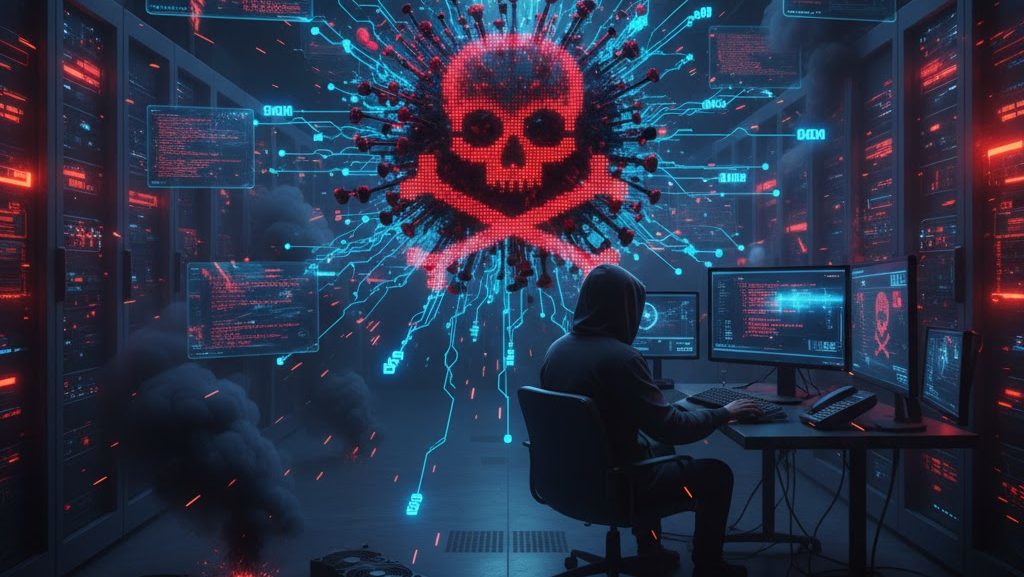Ransomware is no longer a niche cybersecurity problem — it’s a business problem. When malicious actors encrypt systems or steal data and demand payment, the fallout can ripple across finances, operations, reputation, and regulatory compliance. This long-form, SEO-optimized guide explains how ransomware attacks affect U.S. companies, summarizes the latest trends and research, and gives practical, actionable steps business leaders and IT teams can take to prevent, contain, and recover from attacks.
Quick snapshot: why U.S. companies should care right now
Ransomware incidents are increasing in number and cost, and the United States remains a primary target. In 2024–2025 the FBI’s Internet Crime Complaint Center (IC3) reported rising losses tied to ransomware and related cybercrime, while government cybersecurity agencies (CISA) continue to issue frequent advisories about active ransomware groups and techniques. Recent industry reports show average breach and ransomware costs in the millions for affected organizations. Federal Bureau of Investigation+1
What is ransomware — short primer
Ransomware is malware that either (a) encrypts an organization’s files and systems so they can’t be used until a ransom is paid, or (b) exfiltrates sensitive data and threatens to publish it unless demands are met (double extortion). Attackers commonly gain initial access via phishing, credential compromise, unpatched servers, RDP exposure, or vulnerabilities in third-party software. Once inside, they move laterally, escalate privileges, and deploy encryption or data theft tools.
Key modern tactics include:
- Double and triple extortion: encrypt data, steal it, and also target customers/suppliers.
- Ransomware-as-a-Service (RaaS): professionalized ecosystems where developers provide malware and affiliates carry out attacks.
- Targeted social engineering: spear-phishing and business email compromise to get credentials.
- Supply-chain attacks that leverage third-party vendors to reach customers. coveware.com+1
How ransomware affects companies — the damage explained
Ransomware impacts companies across multiple dimensions. Below are the most common and consequential effects.
1. Financial loss — direct and indirect costs
Ransomware’s financial burden is wide-ranging:
- Ransom demands and payments. While law enforcement and many insurers discourage paying, some victims do pay — often millions — to regain access or avoid data leaks. Average ransom and total incident costs have been reported in the millions. PurpleSec+1
- Downtime and lost revenue. Operational disruption is often the costliest element: systems offline means halted sales, missed deadlines, and customer churn. The IBM Cost of a Data Breach reports multi-million-dollar average breach costs, and ransomware scenarios typically sit at the higher end. IBM
- Recovery expenses. Forensic investigations, legal fees, notification costs, PR, restoration, and contracting incident response teams add up quickly.
- Regulatory fines and lawsuits. If personal data is exposed, companies may face legal action and regulatory penalties — especially in regulated industries.
2. Operational disruption and productivity loss
Ransomware can take entire IT environments offline. Manufacturing lines stop, hospitals delay care, and service providers can’t access client records. Even after systems are restored, testing and validation can keep teams out of action for weeks.
3. Reputational damage and customer loss
Publicized incidents can erode trust. Customers and partners may move business elsewhere after learning their data was exposed or a provider’s systems were unreliable during an incident.
4. Legal & regulatory exposure
Breach notification laws (federal and state) often require disclosure to affected individuals and regulators. Healthcare (HIPAA), financial services, and critical infrastructure sectors face additional compliance and reporting requirements that can involve audits and fines.
5. Supply-chain and third-party risk
RaaS and supply-chain attacks can cascade — a vendor compromise can lock out thousands of downstream customers. The number of active ransomware groups and fragmentation of the ecosystem increase the risk. IT Pro
6. Human costs — burnout and morale
Security incidents stress staff, burn out IT teams forced into round-the-clock recovery, and can produce long-term morale problems that harm retention.
Statistics & research: scale and trends (what the data shows)
- The FBI IC3 and industry reports indicate ransomware remains pervasive and costly; IC3 noted ransomware as a persistent threat in 2024 and reported rising complaints and losses. ic3.gov+1
- IBM’s Cost of a Data Breach reported average breach costs in the multi-million dollar range, with significant portions attributable to ransomware incidents and extended downtime. IBM
- Incident response firms and aggregators (Coveware, PurpleSec, Varonis) report rising average ransom demands and total incident costs, often ranging from hundreds of thousands to several million dollars depending on victim size and sector. coveware.com+1
- Government agencies (CISA) publish regular advisories on ransomware groups and TTPs — a helpful signal that attacks are active, evolving, and often targeted at U.S. organizations. CISA+1
Academic and policy research underscores the economic gravity of ransomware: global and sector studies show substantial downtime costs and systemic risk to critical services like healthcare and education. ResearchGate+1
Which industries in the U.S. are most at risk?
Certain sectors are repeatedly targeted due to high-value data and critical operations:
- Healthcare: patient records and the urgency of care make hospitals frequent targets.
- Finance: access to funds and sensitive records is lucrative for criminals.
- Manufacturing: production downtime accelerates financial loss.
- Education: schools and universities often lack robust defenses and hold valuable research and personal data.
- Energy & Critical Infrastructure: disruption has national security implications.
Reports and sector breakdowns in recent years consistently show these industries among the top targets. Fortinet+1
Prevention: the multi-layered defenses that reduce risk
Ransomware prevention needs layers — technical controls + policies + people. Below is a prioritized checklist companies should adopt.
Technical controls
- Regular, tested backups (3-2-1 rule). Keep three copies, on two media types, with one offline/cold. Regularly test restores.
- Patch management & vulnerability reduction. Timely patching of OS, apps, and exposed services (RDP, VPNs) reduces common entry points.
- Endpoint detection and response (EDR) & Next-Gen AV. Behavior-based detection helps catch anomalous activity before full encryption.
- Network segmentation & least privilege. Limit lateral movement with microsegmentation and restrict admin privileges.
- Multi-factor authentication (MFA). Enforce MFA for remote access, VPNs, and privileged accounts.
- Email filtering and web security. Block malicious attachments/links and use DNS filtering to prevent malicious sites.
- Logging, monitoring, and SIEM. Centralized logs and alerts enable faster detection and containment.
- Encrypt sensitive data at rest. While this doesn’t prevent data theft, it raises attacker costs.
Policy & process
- Incident response plan (IRP). Document roles, communication trees, legal/PR procedures, and decisions about ransom payment policies. Test the plan with tabletop exercises.
- Third-party risk management. Vet vendors for security posture, contractually require security controls, and monitor their status.
- Business continuity planning (BCP). Ensure critical operations have manual or alternative workflows.
- Cyber insurance review. Understand coverage limits, obligations, and whether payments require attack mediation with approved vendors.
People & training
- Phishing-resistant culture. Regular, realistic phishing simulations and targeted training lower click rates.
- Access hygiene & password policy. Enforce strong passwords and periodic access reviews.
- Executive awareness. Leadership should understand risks, costs, and the need for investment in defenses.
CISA’s StopRansomware resources and advisories include prioritized mitigations tailored to different organization sizes — they reinforce the layered approach above. CISA+1
Incident response: step-by-step actions if you’re hit
When an attack occurs, speed and process matter. Below is a practical incident response checklist for ransomware.
- Isolate affected systems. Disconnect infected hosts from networks; avoid turning machines off unless instructed.
- Activate your IRP and response team. Notify executives, IT, legal, communications, and third-party responders.
- Preserve logs and evidence. Capture forensic images and logs for investigation and potential legal action.
- Engage external specialists. Bring in an incident response firm and legal counsel experienced in cyber incidents.
- Notify required parties. Depending on laws and contracts: customers, partners, regulators, and insurers must be informed.
- Assess scope & backups. Determine what’s encrypted/exfiltrated and whether reliable backups exist for recovery.
- Communicate clearly but carefully. A prepared communications plan reduces reputational damage.
- Coordinate with law enforcement. File reports with the FBI IC3 and consider CISA notification — they can provide intelligence and may help disrupt attackers. Federal Bureau of Investigation+1
Note on paying ransoms: Payment does not guarantee full recovery or prevention of future extortion. Law enforcement guidance often discourages payment, and some insurers and regulators now restrict it. Decisions about payment should involve legal, financial, and incident response teams. Recent reporting shows many organizations still paid in hopes of faster recovery, but with mixed outcomes. TechRadar+1
Table — Ransomware impact vs. defensive investment (illustrative)
| Impact Area | High Risk if Unprotected | Mitigation & Investment | Expected Benefit |
|---|---|---|---|
| Financial cost | Multi-million incidents | Backups, IR retainer, cyber insurance | Lower ransom/leverage recovery |
| Downtime | Days to weeks offline | Network segmentation, BCP | Reduced outage window |
| Data leakage | Customer & IP exposure | Encryption, DLP, vendor controls | Lower breach scope |
| Legal exposure | Notices, fines | Legal counsel, compliance audits | Faster regulatory response |
| Reputation | Customer loss, media attention | PR plan, transparency | Faster trust recovery |
| Operational resilience | Production stop | Offline procedures, manual ops | Maintain critical services |
Ransomware & cyber insurance — pros, cons, and caveats
Cyber insurance can help with ransom payments (depending on policy), forensic costs, and business interruption. However:
- Policies may have coverage limits and exclusions and often require adherence to best practices.
- Increased claims have tightened underwriting, raised premiums, and added stricter security prerequisites.
- Some insurers now mandate use of approved vendors and require notification to law enforcement.
Before relying on insurance, review policy language carefully with legal and insurance advisors to understand obligations and exclusions.
The role of government and law enforcement
In the U.S., federal agencies play active roles:
- FBI/IC3 document trends, facilitate reporting, and investigate. Federal Bureau of Investigation
- CISA issues advisories, technical guidance, and tactical indicators for active threats (see StopRansomware and Play/Interlock advisories). CISA+1
- State attorneys general and regulatory bodies may enforce data breach laws and consumer protections.
Timely reporting to these bodies helps with intelligence sharing and may inform protective measures for the broader community.
Practical roadmap: 10 immediate actions for business leaders
- Verify backups and test restores today. If you can’t restore reliably, prioritize restoration planning.
- Enable MFA everywhere (privileged accounts first). A fast, high-impact control.
- Patch critical systems and close exposed RDP/VPN ports. Reduce easy entry points.
- Segment networks to limit lateral movement. Separate production, user, and vendor networks.
- Deploy or tune EDR and SIEM for fast detection. Monitoring equals speed in detection.
- Conduct a phishing simulation & staff training this quarter. Human risk reduction.
- Review vendor contracts & require security assurances. Third-party risk is a top vector.
- Create or exercise your IRP (tabletop). Practice decisions under pressure.
- Engage legal counsel & confirm cyber insurance details. Know your obligations.
- Report incidents to FBI IC3 and CISA when they occur. Contribute to national defense & get assistance. Federal Bureau of Investigation+1
University and academic insights
Academic research and policy analysis reinforce practical guidance:
- Studies on economic impacts show that ransomware inflicts measurable macroeconomic damage on affected sectors, and that prevention/mitigation investment reduces systemic risk. ResearchGate+1
- Security research into RaaS and adversarial techniques highlights the need for behavior-based detection and defenses that don’t rely solely on signatures. coveware.com+1
- Public-private collaboration is repeatedly recommended by universities and research centers to augment detection, share threat intelligence, and coordinate responses across sectors.
Frequently Asked Questions (FAQs)
Q: How common are ransomware attacks on U.S. companies?
A: Ransomware is a persistent and common threat. Recent IC3 and industry reports show ransomware continues to be a leading cyber threat affecting U.S. organizations across sectors. Federal Bureau of Investigation+1
Q: Should my company ever pay a ransom?
A: Payment is a complex, high-risk decision. Law enforcement generally discourages payments, and paying doesn’t guarantee recovery or prevent further extortion. Decisions should involve legal counsel, incident responders, and your board — and consider whether insurance policies permit payment. TechRadar+1
Q: How much does a ransomware attack typically cost?
A: Costs vary widely by size and sector. Industry reports (IBM, Coveware, PurpleSec) show average total incident and data breach costs in the millions for many breaches, factoring in ransom demand, downtime, recovery, and reputational losses. IBM+1
Q: What is the fastest way to reduce our ransomware risk?
A: Enforcing MFA, verifying/test backups, patching exposed services, and training staff on phishing are among the highest-impact actions you can take quickly. CISA
Q: Who should we notify if we’re attacked?
A: Notify internal stakeholders, your insurer, and law enforcement (FBI IC3). For significant incidents, notify CISA and relevant regulators based on sector-specific reporting obligations. Legal counsel can advise on breach notification laws. Federal Bureau of Investigation+1
Q: Can small businesses defend against ransomware?
A: Yes. While attackers often target weakly defended organizations, small businesses that implement layered defenses (backups, MFA, patching, training) and maintain a tested IRP significantly reduce their risk and recovery time.


